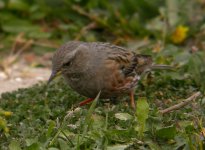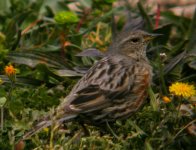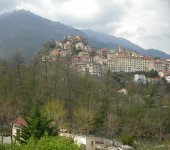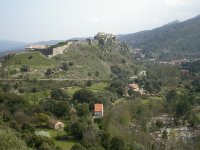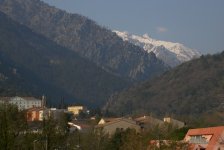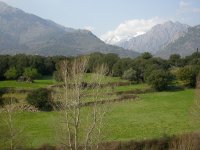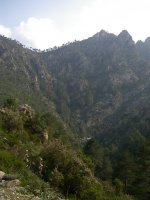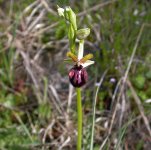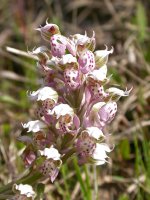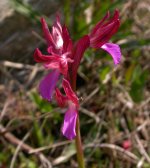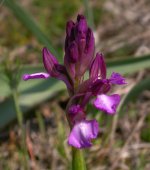I arrived in Bastia at seven in the morning and found my way through the streets to the small train station. From here I travelled for around an hour and a half along the extraordinary railway line to Corte in the centre of the island. The line traverses some remarkable gorges as it passes through forests and fields and then into the mountains. My accommodation was at the cheap, but okay, Hotel HR on the edge of town. After settling into my very big room, I went for a wander into the centre of town, which is sat atop a large rock above the meeting point of the Restonica and Tavignano rivers. It was as I was crossing a footbridge over these that I saw two small finches flit down onto the stony river bed. These were a pair of Corsican Citril Finches, beautiful lemon-yellow birds showing the streaky brown backs that distinguish them from mainland Citril Finches. After enjoying great views of these for several minutes, I continued on into the town centre, picked up some maps and had lunch.
I decided that the best policy for the remainder of the day would be to try to see the legendary Corsican Nuthatch as soon as possible, so I headed off along the slender road through the Restonica valley to seek out some Corsican Pine forest. Corsica has a lot of endemic or near-endemic subspecies so I was looking particularly carefully at a lot of the otherwise familiar species in the woods and scrub. Coal Tits, Treecreepers and Wrens were all ‘different’ but not always strikingly so. The trees were filled with the songs of Blackcaps and Firecrests were seen and heard regularly – these lovely birds proving to be as common in Corsica as anywhere I’ve ever been. A few more Corsican Citril Finches were seen along the forest trails but I was struggling to hear anything that sounded like a Nuthatch. There were other birds to see in the mixture of pine and maquis that lined the sides of the valley though, including a Dartford Warbler and a few Cirl Buntings. I managed some good views of a few Common Crossbills, another island subspecies. Sadly for any of you Crossbill enthusiasts, I lacked the necessarily technology to get a voice recording but the excitement calls sounded a bit sparrow-like to my ears.
Finally, after a bit of ‘encouragement’ from my MP3 player, I heard a liquid trilling in the distance. A bit more of a blast and a tiny short-tailed bird was flying towards me and into the nearest tree: a Corsican Nuthatch. I watched this male bird for several minutes as it rummaged around the pine needles and branches, singing regularly and even, it seemed, visiting a nest hole in a dead tree. A really special few minutes.
As the evening light descended on the valley, there was more excitement on the way. Looking up to the steep crags as I returned to Corte along the road, I saw a large raptor effortlessly gliding up the valley. Much to my astonishment it was a sub-adult Lammergeier, doing its best to look like a giant falcon dressed in the garb of a Hooded Crow. Continuing on I was pleased, as I always am, to see a Dipper along the stream. In Corsica the black-bellied nominate is found. A party of twenty or more Crag Martins zipped into the valley at dusk





